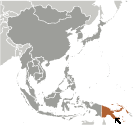World Atlas: Papua New Guinea. On this page you can see the map, country flag and many detailed information about the people, history and economy of Papua New Guinea.

Here you can find online selected information about the geography, inhabitants, government, economy and history of Papua New Guinea. Included are selected statistics, an overview map and the detailed map of Papua New Guinea. But let's start with the flag of Papua New Guinea here:
Papua New Guinea - Overview:
What you should know about Papua New Guinea? Let's start with this: The eastern half of the island of New Guinea - second largest in the world - was divided between Germany (north) and the UK (south) in 1885. The latter area was transferred to Australia in 1902, which occupied the northern portion during World War I and continued to administer the combined areas until independence in 1975. A nine-year secessionist revolt on the island of Bougainville ended in 1997 after claiming some 20,000 lives. Since 2001, Bougainville has experienced autonomy. Under the terms of a peace accord, 2015 is the year that a five-year window opens for a referendum on the question of independence.
Geography of Papua New Guinea
 Where on the globe is Papua New Guinea? The location of this country is Oceania, group of islands including the eastern half of the island of New Guinea between the Coral Sea and the South Pacific Ocean, east of Indonesia. Total area of Papua New Guinea is 462,840 sq km, of which 452,860 sq km is land. So this is quite a large country. How could we describe the terrain of the country? This way: mostly mountains with coastal lowlands and rolling foothills. The lowest point of Papua New Guinea is Pacific Ocean 0 m, the highest point Mount Wilhelm 4,509 m. And the climate is tropical; northwest monsoon (December to March), southeast monsoon (May to October); slight seasonal temperature variation.
Where on the globe is Papua New Guinea? The location of this country is Oceania, group of islands including the eastern half of the island of New Guinea between the Coral Sea and the South Pacific Ocean, east of Indonesia. Total area of Papua New Guinea is 462,840 sq km, of which 452,860 sq km is land. So this is quite a large country. How could we describe the terrain of the country? This way: mostly mountains with coastal lowlands and rolling foothills. The lowest point of Papua New Guinea is Pacific Ocean 0 m, the highest point Mount Wilhelm 4,509 m. And the climate is tropical; northwest monsoon (December to March), southeast monsoon (May to October); slight seasonal temperature variation.
Inhabitants of Papua New Guinea
Let's take a look how many people live in Papua New Guinea. The number is: 6,909,701 (July 2017 est.). So this is not very populous country. Who lives here? Melanesian, Papuan, Negrito, Micronesian, Polynesian. What are the languages in Papua New Guinea? Tok Pisin (official), English (official), Hiri Motu (official), some 839 indigenous languages spoken (about 12% of the world's total); many languages have fewer than 1,000 speakers. And the religions: Roman Catholic 27%, Protestant 69.4% (Evangelical Lutheran 19.5%, United Church 11.5%, Seventh-Day Adventist 10%, Pentecostal 8.6%, Evangelical Alliance 5.2%, Anglican 3.2%, Baptist 2.5%, other Protestant 8.9%), Baha'i 0.3%, indigenous beliefs and other 3.3% (2000 census). How old are the people in average? 23.1 years. We have to add that this number is the median - so one half of the people is older than this, one half is younger. And what is their life expectancy (at birth)? This: 67.3 years. Where the people live in Papua New Guinea? Here: population concentrated in the highlands and eastern coastal areas on the island of New Guinea; predominantly a rural distribution with only about one-fifth of the population residing in urban areas. The major urban areas of Papua New Guinea are: PORT Moresby (capital) 345,000 (2015).
Government and Economy of Papua New Guinea
The capital of Papua New Guinea is Port Moresby and the government type parliamentary democracy (National Parliament) under a constitutional monarchy; a Commonwealth realm. Let's take a look at the administrative divisions - 20 provinces, 1 autonomous region, and 1 district; Bougainville, Central, Chimbu, Eastern Highlands, East New Britain, East Sepik, Enga, Gulf, Hela, Jiwaka, Madang, Manus, Milne Bay, Morobe, National Capital, New Ireland, Northern, Southern Highlands, Western, Western Highlands, West New Britain, West Sepik. Regarding the economy of Papua New Guinea, important industrial products are copra crushing, palm oil processing, plywood production, wood chip production; mining (gold, silver, copper); crude oil and petroleum products; construction, tourism. Important agricultural products are coffee, cocoa, copra, palm kernels, tea, sugar, rubber, sweet potatoes, fruit, vegetables, vanilla; poultry, pork; shellfish. The most important export commodities are oil, gold, copper ore, logs, palm oil, coffee, cocoa, crayfish, prawns and the most important export partners are Singapore 23.7%, Australia 22.9%, Japan 13.2%, China 11.9% (2016). The most important import commodities are machinery and transport equipment, manufactured goods, food, fuels, chemicals and the most important import partners are Australia 36%, China 14.9%, Singapore 8.5%, Malaysia 7.5% (2016). How rich is Papua New Guinea and how rich are people in this country? The most important number here is GDP per capita (PPP): $3,800 (2017 est.). This is a very low number. Let's add that this means Gross Domestic Product per person, which is recalculated with respect to the relative cost of local goods and services. And one more important number - population below poverty line: 37% (2002 est.).